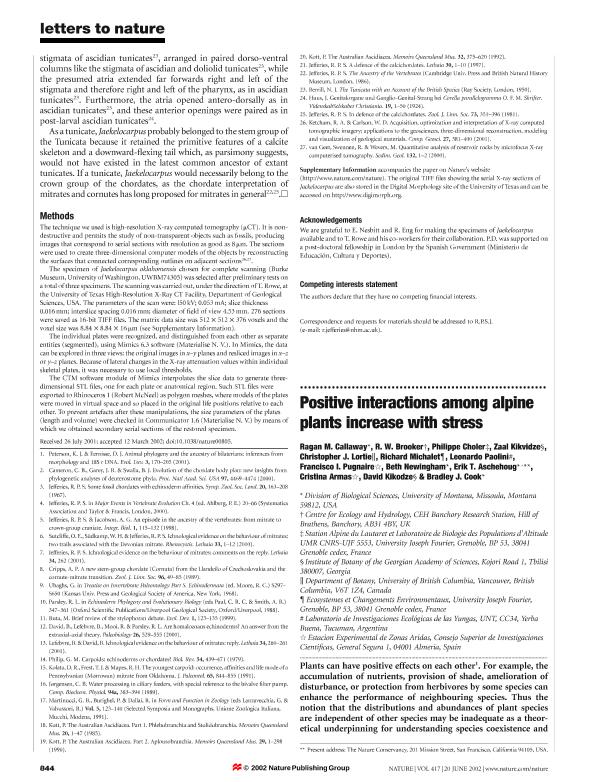Artículo
Positive interactions among alpine plants increase with stress
Callaway, Ragan M.; Brooker, Robert W.; Choler, Philippe; Kikvidze, Zaal; Lortie, Christopher J.; Michalet, Richard; Paolini, Leonardo ; Pugnaire, Francisco I.; Newingham, Beth; Aschehoug, Erik T.; Armas, Cristina; Kikodze, David; Cook, Bradley J.
; Pugnaire, Francisco I.; Newingham, Beth; Aschehoug, Erik T.; Armas, Cristina; Kikodze, David; Cook, Bradley J.
 ; Pugnaire, Francisco I.; Newingham, Beth; Aschehoug, Erik T.; Armas, Cristina; Kikodze, David; Cook, Bradley J.
; Pugnaire, Francisco I.; Newingham, Beth; Aschehoug, Erik T.; Armas, Cristina; Kikodze, David; Cook, Bradley J.
Fecha de publicación:
12/2002
Editorial:
Nature Publishing Group
Revista:
Nature
ISSN:
0028-0836
Idioma:
Inglés
Tipo de recurso:
Artículo publicado
Clasificación temática:
Resumen
Plants can have positive effects on each other. For example, the accumulation of nutrients, provision of shade, amelioration of disturbance, or protection from herbivores by some species can enhance the performance of neighbouring species. Thus the notion that the distributions and abundances of plant species are independent of other species may be inadequate as a theoretical underpinning for understanding species coexistence and diversity. But there have been no large-scale experiments designed to examine the generality of positive interactions in plant communities and their importance relative to competition. Here we show that the biomass, growth and reproduction of alpine plant species are higher when other plants are nearby. In an experiment conducted in subalpine and alpine plant communities with 115 species in 11 different mountain ranges, we find that competition generally, but not exclusively, dominates interactions at lower elevations where conditions are less physically stressful. In contrast, at high elevations where abiotic stress is high the interactions among plants are predominantly positive. Furthermore, across all high and low sites positive interactions are more important at sites with low temperatures in the early summer, but competition prevails at warmer sites.
Palabras clave:
PLANT INTERACTIONS
,
ALPINE
,
ENVIRONMENTAL STRESS
,
GLOBAL EXPERIMENT
Archivos asociados
Licencia
Identificadores
Colecciones
Articulos(CCT - NOA SUR)
Articulos de CTRO.CIENTIFICO TECNOL.CONICET - NOA SUR
Articulos de CTRO.CIENTIFICO TECNOL.CONICET - NOA SUR
Citación
Callaway, Ragan M.; Brooker, Robert W.; Choler, Philippe; Kikvidze, Zaal; Lortie, Christopher J.; et al.; Positive interactions among alpine plants increase with stress; Nature Publishing Group; Nature; 417; 6891; 12-2002; 844-848
Compartir
Altmétricas



